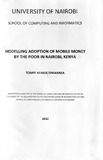| dc.description.abstract | The researcher set out to develop a model that has the power to explain adoption of mobile money among the poor in Kenya.
The researcher reviewed literature on technology adoption models, poverty, mobile telecommunication industry, access to financial services and mobile money services. From the review and a qualitative study, a framework, founded on the Unified Theory of Acceptance and Use of Technology model was then developed. The framework had seven exogenous constructs, two endogenous constructs and five moderating variables. Guided by literature, the researcher identified three measures for each construct. The conceptual framework was then translated into a five point likert scale questionnaire. The researcher tested the instrument and improved it several times before considering it reliable for use.
The researcher then developed a criterion that led to the choice of M-Pesa, Airtel Money and Orange money as the products for investigation. The researcher sampled seven areas from Nairobi that are considered poor. A random technique was used to sample 283 respondents, which was well above the minimum requirement.
Structural Equation Modelling (SEM) was used to conduct a confirmatory analysis and test the relationships between constructs. SEM has a series of steps provided in literature that the researcher followed very meticulously. Moderating variables were tested using multi-group analysis which is a technique used to investigate the impact of moderators on the influence of predictors toward dependent variables. Data analysis was done using SPSS and Analysis of Moment Structure (AMOS).
Some paths and constructs from the original conceptual framework were dropped. In the final analysis, five exogenous constructs, two endogenous constructs and four moderating variables were retained resulting to a proposed model for adoption of mobile money among the poor.
From a theoretical point of view, the mobile money adoption model provides a basis for understanding relationships of the determinants and usage behaviour of mobile money. The relationship between these constructs and variables has a significant theoretical power. Through the literature review and analysis, the research strengthens the appreciation of these constructs and moderators of not only influencing the adoption of technology, but more specifically of mobile money. From a methodological point of view, the study does provide some guidelines for researchers interested in this or related areas. Specifically, researchers interested in mobile technologies, the use of technology by the poor, design of studies, questionnaire design, validity and reliability testing, use of AMOS, SEM, as well as research related to moderating effects would find this thesis useful. The results of this study have significant practical implications. Primarily, it demonstrates that deploying mobile money services because there is perceived demand is not good enough. Given the large investment associated with developing and deploying mobile money services, a good understanding of the drivers of adoption is useful so as to make the organizations allocate their resources appropriately.
The constructs that were retained show what is important to the poor as they choose what mobile money service to adopt. By understanding the need, management will be able to design and deploy valuable services. In the last chapter, the researcher discusses in detail the implication of each of the constructs that was retained in the model.
There were several research conclusions from the study. First, UTAUT is a useful framework for studying technology adoption in both western and non-western societies. Secondly, consistent with other researchers’ findings, generic models need to be contextualised to areas of study. Thirdly, Performance Expectancy, Social Influence and Perceived Trust play an important role in determining Behavioural Intention to use mobile money among the poor and more so in developing countries. In addition, Facilitating Conditions and Transaction Costs influence actual usage. Fourthly, the users’ age, gender, education and risk moderate the relationships between constructs that determine behavioural intention as well as actual usage. Finally, evaluating products and the market is critical before and during deployment of mobile money services.
Key words: Adoption, Base of the Pyramid, Modelling, Mobile Money, UTAUT | en |

